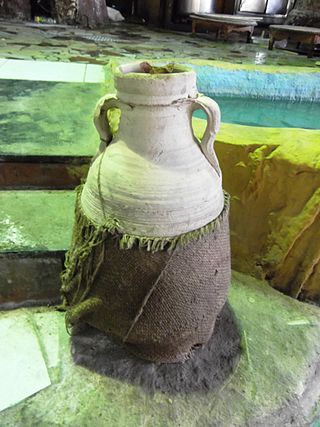
An evaporative cooler is a device that cools air through the evaporation of water. Evaporative cooling differs from other air conditioning systems, which use vapor-compression or absorption refrigeration cycles. Evaporative cooling exploits the fact that water will absorb a relatively large amount of heat in order to evaporate. The temperature of dry air can be dropped significantly through the phase transition of liquid water to water vapor (evaporation). This can cool air using much less energy than refrigeration. In extremely dry climates, evaporative cooling of air has the added benefit of conditioning the air with more moisture for the comfort of building occupants.

A windcatcher, wind tower, or wind scoop is a traditional architectural element used to create cross ventilation and passive cooling in buildings. Windcatchers come in various designs, depending on whether local prevailing winds are unidirectional, bidirectional, or multidirectional, on how they change with altitude, on the daily temperature cycle, on humidity, and on how much dust needs to be removed. Despite the name, windcatchers can also function without wind.
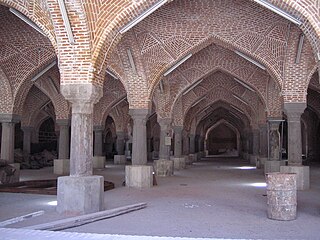
A shabestan or shabistan (Persian: شبستان; Old Persian: 𐎧𐏁𐎱𐎿𐎫𐎠𐎴, romanized: xšapā.stāna, lit. 'night room' is an underground space that can be usually found in traditional architecture of mosques, houses, and schools in ancient Iran.

The Yeni Valide Mosque is an 18th-century Ottoman mosque in the Üsküdar district of Istanbul, Turkey.

The Fountain of Sultan Ahmed III is a fountain in the great square in front of the Imperial Gate of Topkapı Palace in Istanbul, Turkey. It was built under Ottoman sultan Ahmed III in 1728, in the style of the Tulip period. It was a social centre and gathering place during the Ottoman period of Constantinople.

Sabil-Kuttab of Abd al-Rahman Katkhuda is a historic monument in the historic district of Cairo, Egypt. It comprises a public fountain or sabil, an elementary Quran school or kuttab, and an adjacent residential wing. A prime example of Egyptian architecture of its time, it was commissioned in 1744 by Abd al-Rahman Katkhuda, a local official who was a prominent patron of architecture.
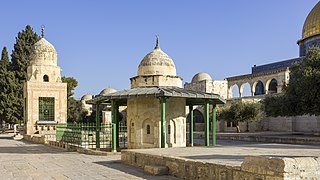
The Fountain of Qasim Pasha is an ablution and drinking fountain in the western esplanade of the al-Aqsa Compound in the Old City of Jerusalem. It is in front of the Chain Gate.

Sabil Abu Nabbut also known as Tabitha's Well is a public fountain ("sabil") in Jaffa, Israel, built in 1815/16 CE during the Ottoman period in Palestine. Its main purpose was to facilitate the journey between Jaffa and Jerusalem.

A shadirvan is a type of fountain that is usually built in the courtyard or near the entrance of mosques, caravanserais, khanqahs, and madrasas, with the main purpose of providing water for drinking or ritual ablutions to several people at the same time, but also as decorative visual or sound elements.

The Sultan al-Ghuri Complex or Funerary complex of Sultan al-Ghuri, also known as al-Ghuriya, is a monumental Islamic religious and funerary complex built by the Mamluk sultan Qansuh al-Ghuri between 1503 and 1505 CE. The complex consists of two major buildings facing each other on al-Mu'izz li-Din Allah street, in the Fahhamin Quarter, in the middle of the historic part of Cairo, Egypt. The eastern side of the complex includes the Sultan's mausoleum, a khanqah, a sabil, and a kuttab, while the western side of the complex is a mosque and madrasa. Today the mosque-madrasa is still open as a mosque while the khanqah-mausoleum is open to visitors as a historic site.
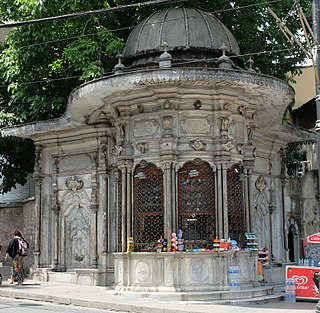
A sabil or sebil is a small kiosk in the Islamic architectural tradition where water is freely dispensed to members of the public by an attendant behind a grilled window. The term is sometimes also used to refer to simple unmanned fountains with a tap for drinking water, though other names often exist for such fountains.

Khan Qırım Giray (1717–1769) was one of the most influential rulers of the Crimean Khanate. He was the patron of the Bakhchisaray Fountain and many Mosques throughout Crimea, and is also known to have extended the Bakhchisaray Palace.

The funerary complex of Sultan Qaytbay is an architectural complex built by the Mamluk sultan al-Ashraf Qaytbay in Cairo's Northern Cemetery. It was built between 1470 and 1474. The main building is a mosque attached to Qaytbay's mausoleum, while other parts of the complex include residential structures, a drinking trough for animals, and a smaller tomb. The complex is considered one of the most beautiful and accomplished monuments of late Mamluk architecture and it is pictured on the Egyptian one pound note.
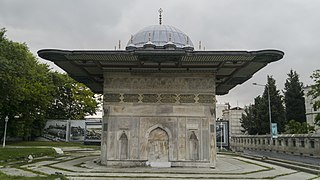
Tophane Fountain is an 18th-century public water fountain built by Ottoman sultan Mahmud I in the Ottoman rococo architecture and situated in the square of Tophane neighborhood in Beyoğlu district of Istanbul, Turkey.

Mosque-Sabil of Sulayman Agha al-Silahdar or Mosque-Sabil-Kuttab of Sulayman Agha al-Silahdar is a complex of mosque, sabil and kuttab established during the era of Muhammad Ali Pasha in Islamic Cairo, the historic medieval district of Cairo, Egypt. It is located at the beginning of Burjouan alley of the famed Muizz Street. On the other side it faces the extension of Al-Nahasin Street leading to the Bab Al-Shaareya square.

The Sabil-Kuttab of Sultan Qaytbay is a Mamluk-era charitable foundation and building in Cairo, Egypt. It was built in 1479 on the order of Sultan al-Ashraf Qaytbay and is located on Saliba Street in the historic districts of Cairo.
Salsabil is an Arabic term referring to a spring or fountain in paradise, mentioned in the Qur'an and in some hadiths. The term is also used as a common and proper noun.

Tulip Period architecture was a stage in Ottoman architecture in the early 18th century. New types of decoration were introduced into the existing classical style of Ottoman architecture and new types of buildings, such as stand-alone fountains and libraries, became important landmarks. The style is most closely associated with the Tulip Period (1718-1730), a period of peace during the reign of Ahmed III when architectural patronage increased in Istanbul after a relative lull in the late 17th century. However, the new style was also present at the beginning of Ahmed III's reign and continued to be evident after him in the 1730s. The introduction of European influences in Ottoman culture and architecture eventually led to the creation of the Ottoman Baroque style in the 1740s.

Ottoman Baroque architecture, also known as Turkish Baroque, was a period in Ottoman architecture in the 18th century and early 19th century which was influenced by European Baroque architecture. Preceded by the changes of the Tulip Period and Tulip Period architecture, the style marked a significant departure from the classical style of Ottoman architecture and introduced new decorative forms to mostly traditional Ottoman building types. It emerged in the 1740s during the reign of Mahmud I (1730–1754) and its most important early monument was the Nuruosmaniye Mosque, completed in 1755. Later in the 18th century, new building types were also introduced based on European influences. The last fully Baroque monuments, such as the Nusretiye Mosque, were built by Mahmud II in the early 19th century, but during this period new European-influenced styles were introduced and supplanted the Baroque.

A kilga is a small stone pedestal on which a large unglazed ceramic water jug is placed. They were designed to catch and direct the filtered water that seeps out from the bottom of the water jug. Kilgas originated in the Fatimid period in Cairo, Egypt, and their design mirrors that of the local architecture, in addition to figural and animal imagery engraved into their marble. Because water was a valuable resource in Cairo, ownership and use of a Kilga was a display of wealth and power as it provided the owner with a source of filtered, cool drinking water. Their use was connected to the Nile river, forming a part of the visual culture of water in Fatimid Egypt.



























